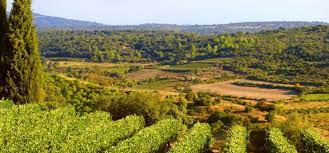
Languedoc is part of what is often called the Languedoc-Roussillon wine region. But it is only natural to dissociate them bothas they represent different wine styles, grape varieties and terroir types in general.
Languedoc spans 3 different French departments, namely L’Aude, le Gard and l’Hérault. In more “wine terms”, this means that the region stretches from Sommières (Languedoc-Sommières) in the east, located near the city of Nîmes, to the Fitou and Corbières appellations in the southwest, near the town of Fitou, where the Roussillon region takes over. Wine grew here as early as 600 BC. The conditions for winemaking are very favorable in Languedoc with the Mediterranean climate that covers larger parts of the region. But Languedoc also proposes very different types of landscape and terroir, so therefore there’s also very different types of wine.
As usual, it was the Greeks who created the vineyard during antiquity and the Romans who developed it and the monks who improved it during the Middle Ages. The expansion of le Canal du Midi in the 17th century, linked the Mediterranean with the Atlantic and gave the wine trade from the Languedoc new opportunities and new markets.
In 1863, the Languedoc was hit hard by the Phylloxera crisis. The vines had to be replaced with hybrid varieties and mass production of low quality wines was privileged. This was the situation until the 1980s, when quality thinking took over, despite the fact that the region still today produces 1/3 of French AOP and IGP wine.
Today, Languedoc comprises 246,000 hectares of cultivated land and 12.7 million hectoliters of wine are produced in Languedoc. 76% of the production is red wine, 14% rosé and 10% white wine. A large number of grape varieties are used, but the most common are Grenache, Syrah, Carignan, Mourvèdre and Cinsault among the red grape varieties and Grenache blanc, Macabeu, Clairette, Picpoul, Vermentino, Bourbelenc, Muscat à petit grains, Muscat d’Alexandrie, Mauzac, Chenin and Ugni blanc, Marsanne, Roussanne and Chardonnay among the white grape varieties.
Languedoc has undergone a major transformation in recent decades where new prestige appellations have been created such as Terasses de Larzac, La Clape, Pic-saint-Loup, Corbières-Boutenac… The taste palette is very wide with mainly red wines covering the range of full-bodied, spicy and oaky wines to lighter fruity wines. As mentioned, the white wines are made from a large number of different grape varieties and give both aromatic dry wines as well as variant wines with their own style and personality. The dessert wines Muscat de Frontignan, Muscat-de-Mireval, Muscat-de-Saint-Jean-de-Minervois and Muscat de Lunel are not to be forgotten and represent their part of the Langedoc region’s invaluable wine production.


